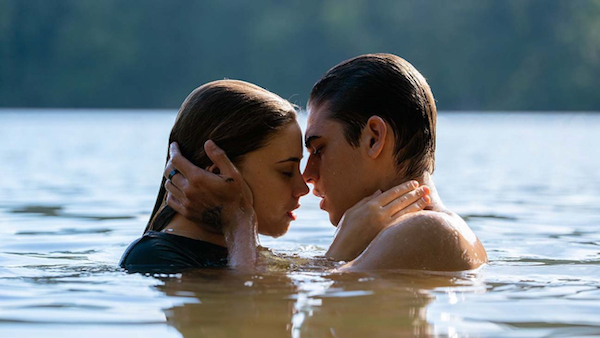Movie review by Greg Carlson
Jennifer Gage’s sudsy “After” offers run-of-the-mill college romance targeted to the PG-13 demographic. The result, a far cry from the lustier stories upon which it is based, misses the mark despite an appealing performance from Josephine Langford as the virginal heroine Tessa Young. Gage, who wrote the screenplay with Susan McMartin, Tamara Chestna, and Tom Betterton, sands the edges off the good-girl-meets-bad-boy narrative, and the tepid result never achieves the entertaining scope of Stephenie Meyer’s genre urtext “Twilight.” Meyer, of course, has long been scrutinized for her fantasy explorations of teen love, sex, and relationships. Accusations of antifeminism continue to be scrutinized in “Twilight” scholarship.
The link between “Twilight” and “After” may be more interesting than the final movie product. “After” began in 2013 as online fan fiction inspired by the pop band One Direction. Author Anna Todd, taking notes from photoshopped mashups that depicted the idolized bandmates as ediger, tougher, tattooed versions of their existing personae, expanded the work into a widely-read series of paperback bestsellers. The publication template was so redolent of E. L. James’ “Fifty Shades of Grey” (which famously began as “Twilight” fanfic) that critics identified in-text parallels, raising questions about the potentially abusive behavior of the brooding Hardin Scott (rechristened from 1D’s Harry Styles). And the similarities don’t end there. Todd, like James, wrote a follow-up in which the story is retold from the male character’s point of view.
Sensible and steady Tessa, a first-year undergraduate embarking on a college adventure filled with nothing but world-is-your-oyster promises of success, immediately falls for Hardin (Hero Fiennes-Tiffin, the one-time Tom Riddle), a troubled looker with serious daddy issues, a buried secret from the past, and a toned canvas for a set of inked body art meant to scream “Danger!” Tessa rebuffs an opportunity for a kiss during a round of truth or dare, delightfully spars with Hardin over matters of character construction in “Pride and Prejudice,” and winds up joining Hardin for a dip in his favorite, secret lake spot. High school sweetheart Noah (Dylan Arnold), to whom Tessa has pledged long-distance commitment and loyalty, doesn’t stand a chance.
While “After” might divide its audiences among hate-watchers, bad movie enthusiasts, and genuine appreciators, the filmmakers deserve applause for the casting of Selma Blair, Peter Gallagher, and Jennifer Beals (all in parental mode). Gallagher and Beals get very little to play, but Blair, whose big-screen breakthrough as Cecile Caldwell twenty years ago in “Cruel Intentions” is sharper than anything that happens in “After,” relishing her scenes as Tessa’s mom Karen. Blair gets to pout and scold and frown at Tessa’s questionable choices, and an angry threat to “cut off” her daughter is as delicious as the thought of Karen inappropriately commiserating with Noah back home. Alas, “After” dares not cross that line, failing as well to muster any kind of truly shocking Hardin bombshell — despite teasing one.
If “After” is supposed to land in the 18-30 year-old market referred to as “new adult,” as opposed to “young adult,” fiction, it’s tough to factor the MPAA rating and the chaste, old-fashioned orientation to sex as anything beyond a desire to allow for a wider range of potential ticket buyers. The movie plays it too safe start to finish. And aside from whatever discussions might emerge concerning the representation of toxicity, masculinity, and toxic masculinity, the lack of originality is the film’s Achilles heel.
